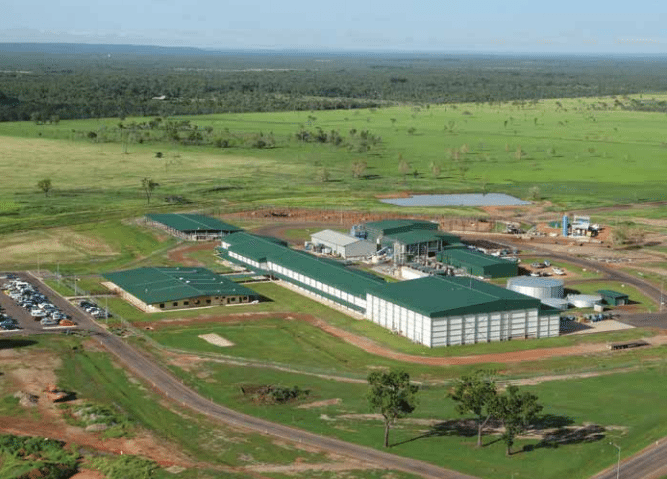THE ghosts of the Australian Agricultural Co’s failed attempt at beef processing near Darwin continue to float through investors’ minds, with a large chunk of questiontime at yesterday’s AA Co annual general meeting taken up by the topic.
There was only a handful of questions from shareholders fielded by the board during the gathering.
 One shareholder asked about the large gap between AA Co’s net tangible assets worth ($2.59 in May), and the share price (yesterday: $1.48).
One shareholder asked about the large gap between AA Co’s net tangible assets worth ($2.59 in May), and the share price (yesterday: $1.48).
Chairman Don McGauchie said the current NTA figure included $550 million of increases in pastoral property improvements over the past two years, extending the NTA/share price gap.
“The board and the executive team are focussed on the areas within our control,” he said, “including generating value for shareholders in delivering the best operating profit and executing on the strategy.”
“Continuing to pursue opportunities under our strategic pillars is the best way to ensure we unlock value for all shareholders,” he said.
Livingstone Beef prospects
Another shareholder asked what the real reasons were behind the Livingstone Beef plant not being utilised in some way, and whether the board could foresee a time when it might re-open.
“I won’t talk about the (non-existent) dividend, but I can live without it,” he added, somewhat wryly.
Livingstone, which cost more than $100 million to build, was shut within 12 months of its launch back in 2018, and has been mothballed ever since.
Mr McGauchie said Livingstone was in an ‘advanced form’ of mothballing, which meant it could be re-activated quite quickly, if necessary.
“We are certainly conscious of keeping the facility in good condition, because infrastructure like that can deteriorate – particularly in the tropics,” he said.

AA Co chairman Don McGauchie addresses yesterday’s AGM
When asked by Beef Central, AA Co was unable to provide a separate line-item figure on the annual site maintenance costs, but industry chatter suggests it may be as much as $1 million each year to keep it in a state of ‘readiness.’
“We have spent money doing that, and also on some upgrades that we see as being of benefit, so we really do still hold Livingstone as an important facility,” Mr McGauchie said.
He said the big challenges for Livingstone were a combination of two issues: supply of cattle, and the (high) cost of freight in any beef export out of Darwin.
“Freight out of Darwin is quite high, compared with other ports,” Mr McGauchie said.
“The people (other beef processors) in the east and south can come into our cattle catchment area and draw cattle away. And on top of that we’ve had some pretty tough seasons in the territory as well.”
“We just don’t have the numbers up there to make Livingstone work. That could change, but the biggest issue, I think, will be the freight cost issue.”
Government role?
“Really, I think there is an opportunity here for us to be talking with the Federal Government about development in the north. There are other industries up there, but we just don’t want the Northern Territory to be a government operation – it needs to have a private sector, and freight cost is a real issue.”
Mr McGauchie said most people understood the reasons for high freight costs in the region, the way container traffic was hubbed out of major collection points like Brisbane and Sydney.
Freight cost had nothing to do with the (Chinese) ownership of the Port of Darwin, he said.
“Freight is a much bigger issue than we realised when we built Livingstone, but we are certainly looking at all opportunities to have the plant open again. I am confident that one day, the circumstances will be there – but northern Australia can be a difficult place to operate.”
“A lot of very good ideas and great visions don’t get to where we’d like them to because of timing – and timing was the great question here.”
“But we will remain ready, and look at every opportunity to get the plant back into action, if we can, because it’s a great asset.”
Robotics answer?
Asked whether robotics and automation, like that seen as Northern Cooperative Meat Co at Casino, might be incorporated at Livingstone to improve the plant’s prospects for re-opening, Mr McGauchie said it would not, at the moment.
“Part of the reason for that is because automation and robotics works best in lambs, where carcases are like peas in a pod, or higher quality cattle of a particular type.
“Part of our problem in the north was that we were using the cattle than nobody else really wanted – old cows and bulls – because all the good young cattle were going out on live export.”
“So introducing automation and artificial intelligence into Livingstone would not achieve very much, because the cattle vary so much. But again, we are all seeing remarkable achievements in these technologies. In one of my other businesses, wool testing, we are moving more and more towards being able to put robotics into production chains,” Mr McGauchie said.
“The modern robots that are now available don’t have to be set in a great cage and kept away from people. They can be put into production chains, with people working beside them. There are ways of introducing these technologies into systems more slowly, without having to make a very big investment off the bat.”
Long-gone are the large attendances at AA Co annual general meetings seen in the past.
Yesterday’s gathering in Brisbane, live-streamed for the convenience of those shareholders who chose not at attend, attracted an audience of only about 40 people. About a dozen of those were AA Co staff, with the balance being a handful of ‘suits’ (institutional investors) plus a few loyal ‘ma and pa’ investors.
